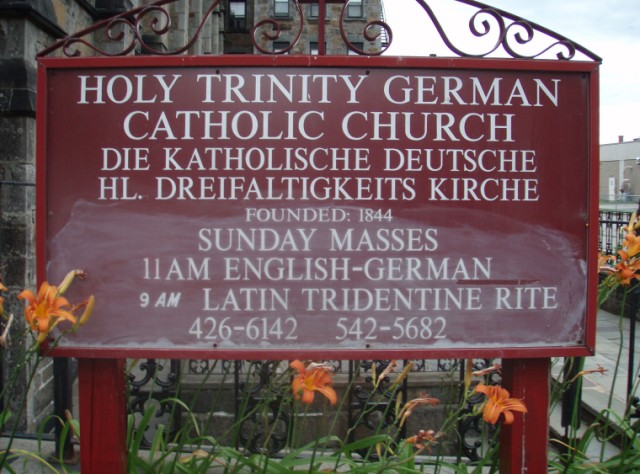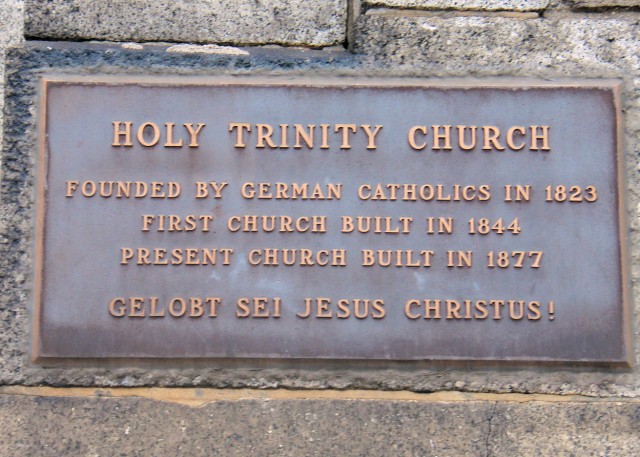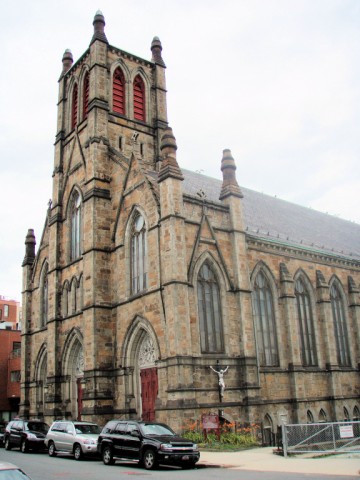
From the church web site
In the early 19th Century, German immigrants landing in Boston faced the challenge of adapting to a new social environment, while striving to preserve their unique cultural and religious heritage Foremost among their concerns was the fear that a rapid assimilation into American society would result in a loss of their cultural identity and even of their Faith.
While Boston’s predominantly Irish pastors tried to be responsive to the needs of their German Catholic flock, none of them spoke German, and so they could neither preach nor hear confessions in the immigrants’ native tongue. They were also unfamiliar with German religious traditions including age-old customs that revolved around important religious holy days. For example, Germans traditionally put a high priority on the celebration of Christmas. In fact, it was German immigrants in Boston who introduced the use of Christmas trees and greeting cards to New England. They also celebrated Easter in a unique way by participating in a wake from Good Friday until Easter Sunday at the Holy Grave with a figure of the dead Christ lying in the ground.
Sympathetic to their plight, Bishop Benedict Joseph Fenwick, S.J. (consecrated 2nd Bishop of Boston in 1825) requested secular clergy from Germany. Between 1836-1846 five priests answered the bishop’s call, but they all moved on, wishing to serve where there were larger German Catholic populations in the Midwest.
In interim periods, Rev. John Stephen Raffeiner from the Diocese of New York traveled several times a year to Boston to minister to the German Catholic community. Recognizing the need for a permanent German parish and clergy, Fr. Raffeiner diligently worked for the establishment of a German national parish. Under his leadership, the cornerstone for Holy Trinity (German) Church was laid in June 1842, constructed of Roxbury puddingstone and Maine granite and sporting two imposing towers, and with the generous assistance of Bishop Fenwick, the church building was completed and the first mass celebrated in June 1844.

Later Fr. Reiter, S.J. took on the task of paying-down the parish’s debts and raising money to buy land on Shawmut avenue in order to build a bigger church. The cornerstone was laid by Bishop John Williams on November 10, 1872 and was completed by Fr. Reiter’s successor, Fr. James Simeon, S.J. (1870-1877) with the first Mass celebrated in the church basement on May 1, 1874. On May 27, 1877, the Feast of the Holy Trinity, Archbishop Williams (who became Boston’s first archbishop in 1875) dedicated the new church, which cost roughly a quarter of a million dollars for the church, land, and rectory.
The new building with seating for 1,200 parishioners upstairs and 700 in the lower church, was, like the first church, made from Roxbury puddingstone and Maine granite. But unlike the first structure it had tall central steeple that graced Boston’s South End skyline until 1938 when a hurricane damaged it to the point where it had to be removed.

Holy Trinity was designed by one of New England's most distinguished church architects, a Brooklyn native named Patrick C. Keely. Keely designed over sixteen cathedrals (including Boston's) and six hundred churches throughout the country.
Holy Trinity is known as the Christmas Parish, having introduced to New England and the country many of the Christmas customs that were brought here by German immigrants during the early and mid-1800s, including the ever-popular decorated pine Christmas Tree and also the German Candlelight Procession and Midnight Mass.
Around 1850, Louis Prang, a German immigrant to Boston, began the practice of exchanging hand-made Christmas holiday cards with his friends. By 1865 he was printing and selling multi-colored cards throughout the United States. To this day he is considered the "Father of the Greeting Card Industry."